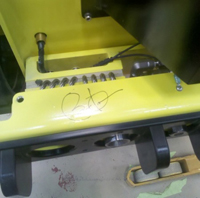News Brief: CMU Applauds National Robotics Initiative
By Teresa Thomas
 As part of President Barack Obama's visit to Carnegie Mellon last Friday (June 24), it was announced that the National Science Foundation (NSF) will take the lead with NASA and two other federal agencies to support the administration's National Robotics Initiative (NRI). The initiative complements the administration's Advanced Manufacturing Partnership and technology transfer efforts, and supports the development and use of robots in the United States that work beside or cooperatively with people and that enhance individual human capabilities, performance and safety.
As part of President Barack Obama's visit to Carnegie Mellon last Friday (June 24), it was announced that the National Science Foundation (NSF) will take the lead with NASA and two other federal agencies to support the administration's National Robotics Initiative (NRI). The initiative complements the administration's Advanced Manufacturing Partnership and technology transfer efforts, and supports the development and use of robots in the United States that work beside or cooperatively with people and that enhance individual human capabilities, performance and safety.
Over the past five years, tremendous advancements in robotics technology have enabled a new generation of assistive systems and devices in industries as diverse as manufacturing, logistics, medicine, health care, military, agriculture and consumer products. Organizations constituting the National Robotics Roundtable, including Carnegie Mellon, applauded the administration's National Robotics Initiative and touted the role robotics and unmanned systems will play in creating jobs, strengthening the economy and ensuring American competitiveness in the global marketplace.
"The steps announced by the President will advance U.S. leadership, spur new industries and create new jobs," said Jared L. Cohon, president of Carnegie Mellon. "Robotics is at the heart of the race for 21st century global economic leadership, as current and emerging robotic innovations will become increasingly vital to keeping us healthy, safe and prosperous in the next decade and beyond. Now, more than ever, it's important that industry, academia, and government work together to ensure our economic security and global competitiveness."
The purpose of the NRI is to encourage innovative collaborative research that combines computer and systems science with mechanical, electrical and materials engineering, and social, behavioral and economic sciences to tackle the most important and challenging problems in robotics, including production of human-assisting co-robots. One goal of the initiative is to stimulate the development and utilization of new computational algorithms, modeling, and analytical techniques in a range of human augmentation tasks. Another goal is to encourage the establishment of new cross-disciplinary research collaborations.
Additionally, robotics science and technology together with the science of learning have the potential to play a very important role in Science, Technology, Engineering and Mathematics education as a unique, integrative discipline that brings together basic science, applied engineering, and creative thinking. Investments in NRI from NASA, NIH, NSF and the USDA may reach $40 to $50 million in the first year with anticipated growth in funding as other agencies and industry partners engage.
For more information, see:
http://www.nsf.gov/news/news_summ.jsp?cntn_id=119911&org=NSF&from=news
http://www.roboticsroundtable.org/
Pictured above is President Obama's signature on Sensabot, one of the CMU robots on display during his talk at Carnegie Mellon's National Robotics Engineering Center. Sensabot was developed to perform inspection tasks in hazardous environments and isolated facilities. Photo by CMU's Byron Spice.